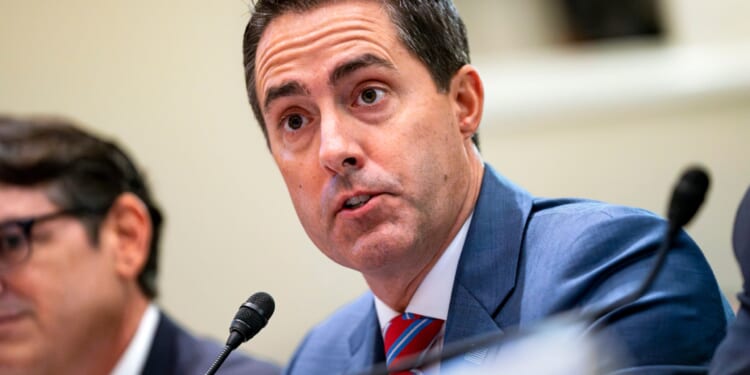The Ohio redistricting committee, just beating its Oct. 31 deadline, has agreed to new congressional districting maps for the 2026 cycle. The new map gives Republicans a 12-3 advantage with Ohio’s 15 congressional districts and spares the state a redistricting fight that would have been more consequential and involving for both sides.
Ohio Republican Party State Central Committeeman Tony Schroeder spoke with The Daily Signal about the new maps.
“I will say I feel confident that we are going to wind up winning in Ohio 9, and that’s we have a very good chance of winning in Ohio 1 as well,” Schroder said, speaking about districts currently represented by Democrat Reps. Marcy Kaptur and Greg Landsman, respectively. “And to me, I think the end result would have been worth the process that we went through and in the deal that we made in order to make this a situation where we have two more seats in D.C.,” he added.
Schroeder’s comments underscore the very important process undertaken to avoid the Pandora’s box that would have been opened had the Republican-led commission pushed for a wider 13-2 district breakdown in favor of the GOP, as opposed to the newly approved 12-3 map.
The committee was chaired by state Rep. Brian Stewart, a Republican who was quite vocal about the process over social media.
Perhaps most importantly, Stewart’s Friday afternoon post spoke to the confines of the Ohio constitution:
2. Ohio voters overwhelmingly amended our state constitution in 2018 to create a process that effectively mandates 2 very blue seats in Franklin and Cuyahoga counties. So, a 15-0 map was never remotely realistic here. 13-2 is the most that’s actually feasible, even that’s a big stretch, and a 13-2 map would require multiple, marginal toss-up seats.
3. If the Redistricting Commission did not come to a bipartisan deal, and the legislature did a 13-2 map, that map would very likely be subject to referendum. Even if the referendum ultimately failed, the state constitution says we’d be stuck with the current 10R-5D map for 2026 if Democrats gather enough signatures to put the question on the ballot. That means for the remainder of President [Donald] Trump’s term, we would have zero R pick up opportunities. Instead, with this map (and no referendum), we get 2.
Democrats had in mind a referendum on redistricting. Republicans going for a 13-2 map in favor of the GOP would have made a referendum from Democrats even more likely, it was feared.
Laws in Ohio are subject to referendum, which, whether or not this one ultimately passed, would have seen the challenged maps frozen. Further, there were concerns that Democrats could have benefited from a referendum, including with increased turnout.
Schroeder was particularly vocal on X about the need to avoid a referendum.
Schroeder and Stewart aren’t the only ones to emphasize such a position, though.
Ohio Secretary of State Frank LaRose put out a statement on X emphasizing how the bipartisan agreement avoided a “chaotic and costly” referendum fight.
LaRose devoted a considerable portion of his statement to issuing further warnings about a Democrat-sponsored referendum:
Dark money special interest groups were already vowing to take the new map to the ballot, almost certainly resulting in costly litigation, disruption to our election process, and confusion for Ohio voters. The state constitution requires us to administer elections on the current district map until a new one takes effect. If opponents of this new 12-3 map had successfully filed a petition to challenge it, a federal court likely would’ve ordered us to use the current 10-5 map for the 2026 election cycle. At that point, we would’ve had no choice but to move the statewide congressional primary election to August at a cost of $50 million to taxpayers. A bipartisan outcome in the commission avoids all of that.
Our election officials already face the prospect of at least six proposed constitutional amendments on next year’s ballot. Adding a third statewide election to that workload is neither good for the vitality of our system nor helpful to the voters. While I didn’t draw this map, it more accurately reflects Ohio’s constitutional requirements, as well as the political proportionality of the electorate over the last decade. By reaching a unanimous, bipartisan outcome, we avoided a referendum that could’ve resulted in something much worse. For that reason, I voted yes.”
The top three House races to watch out of Ohio are currently held by vulnerable Democrat incumbents: Kaptur, Landsman, and Rep. Emilia Sykes of the 13th Congressional District.
All three incumbents have been targeted by the National Republican Congressional Committee, which is optimistic ahead of the 2026 midterms. “House Republicans have the money, message, and momentum to win in 2026 in Ohio and across the country,” NRCC Spokesman Zach Bannon told The Daily Signal.
Kaptur and Landsman’s districts have been redrawn to more so favor Republicans, while Sykes’ district now so more favors the congresswoman.
The race ratings have thus all shifted. Larry Sabato’s Crystal Ball considers Ohio’s 9th to go from a “Toss-up” race to “Lean Republican,” for the 13th to go from “Toss-up” to “Lean Democrat,” and the 1st to go from “Lean Democrat” to a “Toss-up.” Cook Political Report also has the same ratings.
The races have gotten shaken up in other ways as well. Kevin Coughlin, a Republican who came close to unseating Sykes last year and who was initially seeking a rematch, has decided not to run after all.
Meanwhile, State Rep. Josh Williams and Kaptur have both been posting to X about their thoughts on the map, with Williams slamming the mainstay Kaptur, whom he hopes to challenge next year: “It wouldn’t be as much fun if I didn’t get to beat a career politician that has been in office longer than I’ve been alive.”
















